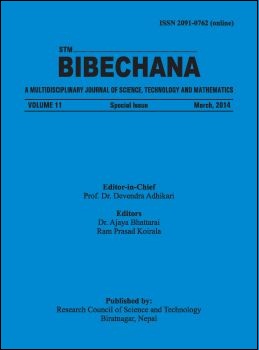Segregation in Fe-Pd melt at 1873 K
DOI:
https://doi.org/10.3126/bibechana.v11i0.10386Keywords:
Fe-Pd alloy, Thermodynamic properties, Interaction energy parameters, Equilibrium constant, SegregationAbstract
The thermodynamic and structural properties of Fe-Pd liquid alloys at 1873 K have been computed using regular associated solution model. To compute these functions we have estimated the mole fractions of the complex assuming the existence of FePd3 complex in the melt. The thermodynamic properties such as free energy of mixing (GM), heat of mixing (HM), entropy of mixing (SM) and activity (a) of the melt have been estimated. To understand the microscopic structural properties, we have estimated the concentration fluctuation in long wavelength limit (Scc(0)) and the Warren-Cowley short range parameter (α1). The free energy of mixing was found to be negative at all compositions. But the heat of mixing and the entropy of mixing are found to be positive at all compositions. The equilibrium constant (K) is found be less than negative. The interaction energy parameters (w12, w13 and w23) are all found to be positive and temperature dependent. The theoretical estimation of the concentration fluctuation in long wavelength limit (SCC (0)) is found to be greater than the ideal values throughout the whole range. The theoretical analysis suggests that the Fe-Pd liquid alloy at 1873 K near the melting point is segregating (homo-coordinating) system. The Warren-Cowley short range order parameter is found to be positive which too suggest the homocoordinating (segregating) nature of the system at all compositions. The theoretical analysis also suggests that the Fe-Pd liquid alloy near melting point is weakly interacting system.
DOI: http://dx.doi.org/10.3126/bibechana.v11i0.10386
BIBECHANA 11(1) (2014) 86-93
Downloads
Downloads
Published
How to Cite
Issue
Section
License
This license enables reusers to distribute, remix, adapt, and build upon the material in any medium or format for noncommercial purposes only, and only so long as attribution is given to the creator.




